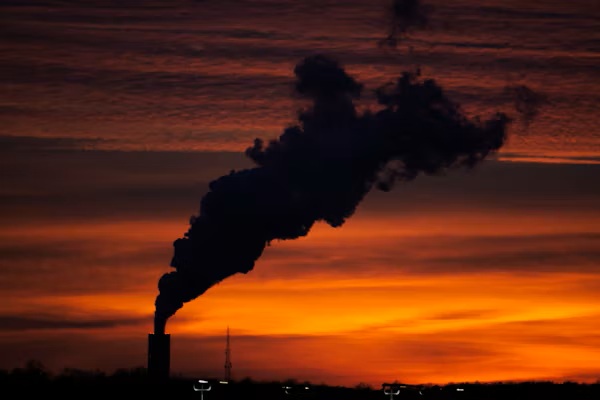
The latest UNEP Emissions Gap Report 2024 warns that global greenhouse-gas emissions have hit a record high, pushing the planet toward nearly 3 °C of warming by century’s end. Five major emitters — China, the United States, India, the European Union, and Russia — now account for over 60 % of the world’s emissions, with India recording the largest absolute increase in 2024. While India’s per-capita emissions remain low and its renewable capacity is expanding, its rapid industrial growth poses a crucial test for global climate goals as the world races to keep the 1.5 °C target within reach.
By Newswriters News Desk
Global greenhouse-gas (GHG) emissions have climbed to a new record, according to the United Nations Environment Programme’s (UNEP) Emissions Gap Report 2024, released ahead of COP-30. The report warns that the planet is on course for a temperature rise of up to 3 °C by the end of the century unless countries drastically cut emissions in this decade.
UNEP says that to keep the Paris Agreement’s 1.5 °C target within reach, global emissions must fall 42 % by 2030 and 57 % by 2035 from 2019 levels. Instead, total GHG emissions rose again in 2024, reaching more than 57 gigatonnes of CO₂-equivalent — the highest level ever recorded. Current national pledges, UNEP adds, “leave the world heading toward catastrophic warming.”
The World’s Top Emitters
The report identifies five countries and regions responsible for the bulk of global GHG emissions:
| Rank | Country / Region | Approximate Share of Global Emissions |
| 1 | China | ~30 % |
| 2 | United States | ~11 % |
| 3 | India | ~8 % |
| 4 | European Union (27) | ~6 % |
| 5 | Russia | ~5 % |
Together, these five account for more than 60 % of total global emissions. China’s reliance on coal continues to dominate global totals, while the United States remains the second-largest emitter despite a decline in coal use. India, for the first time, firmly ranks third, surpassing the European Union in total GHG output — reflecting both its rapid economic growth and surging energy demand.
India’s Rising Emissions — A Development Dilemma
India’s GHG emissions rose sharply in 2024, according to UNEP and national data. Media analyses of the report note that India recorded the largest absolute increase in emissions among major economies. The main drivers are electricity generation, construction, and transport — sectors expanding rapidly in step with industrialisation and urbanisation.
However, India’s per-capita emissions remain among the lowest in the G-20. While India emits roughly two tonnes of CO₂ per person per year, the figure for the U.S. exceeds 14 tonnes, and for China about 8 tonnes.
India also points to significant progress in reducing its emissions intensity (emissions per unit of GDP), which has fallen 36 % since 2005, and in expanding renewables — now accounting for over 44 % of installed electricity capacity.
In its Fourth Biennial Update Report to the UNFCCC, India reported gross emissions (excluding forestry) of 2.96 billion tonnes CO₂-eq in 2020, with net emissions (including land use and forestry) at 2.43 billion tonnes — a 7.9 % decline from 2019.
Global Picture: Emissions Still Rising
The UNEP report confirms that fossil fuels remain the main culprit, responsible for about 75 % of total GHG emissions. While Europe and Japan have begun to decouple economic growth from emissions, global totals are rising because of fast-growing economies in Asia and Africa.
The World Meteorological Organization (WMO) separately reported that atmospheric CO₂ concentrations reached 423.5 ppm in 2024, the highest in 800,000 years, with methane (CH₄) and nitrous oxide (N₂O) levels also at record highs.
UNEP cautions that the emissions gap — the difference between projected emissions under current policies and what’s needed for 1.5 °C — now stands at roughly 22 gigatonnes CO₂-eq per year. At present rates, the carbon budget for 1.5 °C will be exhausted by 2032.
India’s Policy Commitments
India’s climate policy rests on balancing growth with sustainability. Its updated Nationally Determined Contribution (NDC) commits to:
- Reduce emissions intensity of GDP by 45 % by 2030 (from 2005 levels)
- Achieve 50 % cumulative electric power capacity from non-fossil sources by 2030
- Reach net-zero emissions by 2070
To meet these goals, India has accelerated solar and wind installations, launched the Green Hydrogen Mission, and expanded EV adoption. Yet, coal still accounts for nearly 70 % of power generation, making a swift transition challenging.
The Global Equation
UNEP stresses that while developed countries must accelerate decarbonisation and honour their finance pledges, emerging economies like India will shape the global outcome. The top five emitters collectively hold the key: if each achieves deep cuts consistent with 1.5 °C, global emissions could peak within this decade; if not, the world faces escalating risks — extreme heat, food insecurity, sea-level rise, and mass displacement.
Bottom Line
The latest UNEP report delivers a stark message: despite progress on renewables and pledges of net zero, the world’s greenhouse-gas emissions are still increasing. China, the U.S., India, the EU, and Russia together drive over 60 % of the total — and among them, India’s rise stands out as both a challenge and an opportunity.
India’s rapid development will define whether global climate goals remain achievable. Its ability to grow while cutting emissions intensity may offer a model for other emerging economies. But time is running out: as UNEP’s Executive Director Inger Andersen put it, “Every year of delay makes the mountain steeper. The window for keeping 1.5 °C alive is closing — fast.”
Photo: Unsplash



